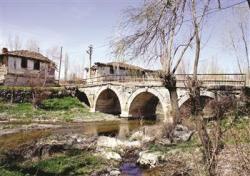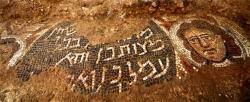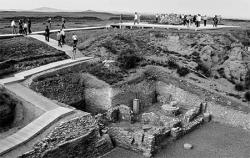INSTITUT SUPERIEUR D'ANTHROPOLOGIE
INSTITUTE OF ANTHROPOLOGY
ONLINE COURSES / COURS A DISTANCE
INSCRIPTION 2012 / Session III : Juillet 2012
REGISTRATION 2012 / Term III : July 2012
PEROU –  Marcahuamachuco - Archeologists in Peru have discovered a sundial, an underground tunnel and a reception room in a complex dating back to the Wari civilization. One of the relics is believed to be a precursor to an Incan sundial, while 18 niches painted in white on the walls may have held ancestral mummies, Joseph Ochatoma, leading the excavation, told the newspaper. Ochatoma added that the reception room is shaped like the letter “D” and is surrounded by platforms. The complex, situated in the the Andean region of Ayacucho was discovered in 1931. The first excavations there began in 1942 but were cut short due to budget shortfalls. Today, archeologists from the San Cristobal de Huamanga National University are perusing the area for more information about the Wari civilization that dates back to between 600 and 1100 AD, Ochatoma said.
Marcahuamachuco - Archeologists in Peru have discovered a sundial, an underground tunnel and a reception room in a complex dating back to the Wari civilization. One of the relics is believed to be a precursor to an Incan sundial, while 18 niches painted in white on the walls may have held ancestral mummies, Joseph Ochatoma, leading the excavation, told the newspaper. Ochatoma added that the reception room is shaped like the letter “D” and is surrounded by platforms. The complex, situated in the the Andean region of Ayacucho was discovered in 1931. The first excavations there began in 1942 but were cut short due to budget shortfalls. Today, archeologists from the San Cristobal de Huamanga National University are perusing the area for more information about the Wari civilization that dates back to between 600 and 1100 AD, Ochatoma said.
http://www.rawstory.com/rs/2012/07/01/peruvian-archaeologists-unearth-pre-inca-relics/
TURQUIE –  Aizanoi - A bridge built by Roman merchant Apuleius Eurykles in the ancient city of Aizanoi some 2,000 years ago, after he and his family survived a sea accident, is now being restored by a Turkish businessman who also survived a sea accident. The Roman benefactor, Eurykles, wrote in the inscription of the bridge that he and his family had survived a sea accident and built the bridge in the ancient city of Aizanoi, now located in the Aegean province of Kütahya’s Çavdarhisar district. “Eurykles even wrote in the inscription that he had seen very interesting sea creatures, and put images of these creatures on the walls,” Özer said. The bridge is now undergoing a restoration sponsored Anemon Hotels, owned by İsmail Akçura, who barely survived a sea accident with his family in 2008 in Marmaris when his yacht filled with water. The excavation team is classifying stones from historical structures in the ancient city, and the area will eventually become a tourist attraction, she said. Excavations continue around the Temple of Zeus as well as the stadium and bath structures, Özer said. “Our team includes women who used to work in the fields. They are working very carefully and learning about archaeological digs. They are employed, even for a short time.”
Aizanoi - A bridge built by Roman merchant Apuleius Eurykles in the ancient city of Aizanoi some 2,000 years ago, after he and his family survived a sea accident, is now being restored by a Turkish businessman who also survived a sea accident. The Roman benefactor, Eurykles, wrote in the inscription of the bridge that he and his family had survived a sea accident and built the bridge in the ancient city of Aizanoi, now located in the Aegean province of Kütahya’s Çavdarhisar district. “Eurykles even wrote in the inscription that he had seen very interesting sea creatures, and put images of these creatures on the walls,” Özer said. The bridge is now undergoing a restoration sponsored Anemon Hotels, owned by İsmail Akçura, who barely survived a sea accident with his family in 2008 in Marmaris when his yacht filled with water. The excavation team is classifying stones from historical structures in the ancient city, and the area will eventually become a tourist attraction, she said. Excavations continue around the Temple of Zeus as well as the stadium and bath structures, Özer said. “Our team includes women who used to work in the fields. They are working very carefully and learning about archaeological digs. They are employed, even for a short time.”
http://www.hurriyetdailynews.com/ancient-bridge-at-aizanoi-to-be-restored.aspx?pageID=238&nID=24471&NewsCatID=375
ISRAEL –  Huqoq - Archaeologists have unearthed the remains of a monumental synagogue building dating to the Late Roman period at the archaeological site of Huqoq in Galilee. Huqoq is an ancient Jewish village located approximately two to three miles west of Capernaum and Migdal (Magdala). During the second season of excavations, the team discovered portions of a stunning mosaic floor decorating the interior of the synagogue building. The mosaic, which is made of tiny colored stone cubes of the highest quality, includes a scene depicting Samson placing torches between the tails of foxes – as related in the book of Judges 15. In another part of the mosaic, two human (apparently female) faces flank a circular medallion with a Hebrew inscription that refers to rewards for those who performgood deeds. “This discovery is significant because only a small number of ancient (Late Roman) synagogue buildings are decorated with mosaics showing biblical scenes, and only two others have scenes with Samson (one is at another site just a couple of miles from Huqoq),” said Jodi Magness, the Kenan Distinguished Professor at the University of North Carolina at Chapel Hill. “Our mosaics are also important because of their high artistic quality and the tiny size of the mosaic cubes,” Prof Magness said. “This, together with the monumental size of the stones used to construct the synagogue’s walls, suggest a high level of prosperity in this village, as the building clearly was very costly.”
Huqoq - Archaeologists have unearthed the remains of a monumental synagogue building dating to the Late Roman period at the archaeological site of Huqoq in Galilee. Huqoq is an ancient Jewish village located approximately two to three miles west of Capernaum and Migdal (Magdala). During the second season of excavations, the team discovered portions of a stunning mosaic floor decorating the interior of the synagogue building. The mosaic, which is made of tiny colored stone cubes of the highest quality, includes a scene depicting Samson placing torches between the tails of foxes – as related in the book of Judges 15. In another part of the mosaic, two human (apparently female) faces flank a circular medallion with a Hebrew inscription that refers to rewards for those who performgood deeds. “This discovery is significant because only a small number of ancient (Late Roman) synagogue buildings are decorated with mosaics showing biblical scenes, and only two others have scenes with Samson (one is at another site just a couple of miles from Huqoq),” said Jodi Magness, the Kenan Distinguished Professor at the University of North Carolina at Chapel Hill. “Our mosaics are also important because of their high artistic quality and the tiny size of the mosaic cubes,” Prof Magness said. “This, together with the monumental size of the stones used to construct the synagogue’s walls, suggest a high level of prosperity in this village, as the building clearly was very costly.”
http://www.sci-news.com/archaeology/article00436.html
SUEDE –  Uppsala - Major excavations are taking place in Old Uppsala because of railway work. Old Uppsala was a political, religious and mercantile centre from about AD 600 to 1274. In fact it may be termed thecentral place of the Swedes – tribe and kingdom – during those centuries. My friend, author Kristina Ekero Eriksson, is the fieldwork’s outreach officer and keeps a blog. So far there hasn’t been much to report beyond what you might expect on a contract excavation in the region, but now some interesting stuff is popping up. How about some long lines of regularly spaced stone-filled pits ? They’re in the big field south of the Royal Barrows, and they look like they once held standing stones like the ones along the ancient road at the Anundshög barrow in the neighbouring province. Huge Late Iron Age barrows and roads lined with standing stones… Now all we need are the foundations of some good stone ships at Old Uppsala to complete the picture of a Viking Period royal centre!
Uppsala - Major excavations are taking place in Old Uppsala because of railway work. Old Uppsala was a political, religious and mercantile centre from about AD 600 to 1274. In fact it may be termed thecentral place of the Swedes – tribe and kingdom – during those centuries. My friend, author Kristina Ekero Eriksson, is the fieldwork’s outreach officer and keeps a blog. So far there hasn’t been much to report beyond what you might expect on a contract excavation in the region, but now some interesting stuff is popping up. How about some long lines of regularly spaced stone-filled pits ? They’re in the big field south of the Royal Barrows, and they look like they once held standing stones like the ones along the ancient road at the Anundshög barrow in the neighbouring province. Huge Late Iron Age barrows and roads lined with standing stones… Now all we need are the foundations of some good stone ships at Old Uppsala to complete the picture of a Viking Period royal centre!
http://scienceblogs.com/aardvarchaeology/2012/06/29/old-uppsala-big-dig-standing-stone-alignments/
ANGOLA - Baía Farta - An archaeological mission discovered last weekend an ancient ceramics site, beads, shells and iron objects in the archaeological Cachama station, five kilometres from the Baía Farta Municipality, Benguela Province. The mission, consisting of experts from the National Archaeological Museum and 40 students from the Katyavala Bwila University was led by French archaeologist Manuel Gutierrez and professor of Paris-I University.
http://www.portalangop.co.ao/motix/en_us/noticias/lazer-e-cultura/2012/6/27/Archaeological-mission-discovers-ancient-ceramics-site-Baia-Farta,71b41105-1ddf-47d8-8199-ecba1d41f4c5.html
CHINE –  Xanadu - Friday marked a historic day for the Site of Xanadu in the Inner Mongolia autonomous region as it gained a place on the World Heritage List. "Xanadu is the best-preserved among the Yuan (Dynasty's) capital cities and has lasted thelongest," said Tong Mingkang, deputy director of State Administration of Cultural Heritage."It's the only intact evidence of the rise and fall of the Yuan Dynasty (1271-1368), whichwitnessed the unique fusion of agrarian Han Chinese and nomadic Mongolian civilizations in northern Asia. "Lying in Zhenglan Banner and Duolun county of the Xilin Gol League in central Inner Mongolia,Xanadu was the first capital of Kublai Khan (1215-94) and later became the summer capital of the Yuan Dynasty.Six of 11 Yuan emperors ascended to the throne in Xanadu. But the city was destroyed in firesover the course of a decade starting in 1358 and eventually abandoned.Shaped like a square, Xanadu has a central axis marked by an imperial city and a palace city,which is surrounded by an outer city. When the Yuan Dynasty moved its capital to Beijing, itbuilt the Forbidden City in a position that aligned it with Xanadu's axis.Archaeological explorations have uncovered the underground remains of the old capital, whichhad been covered by grasslands. Since 2008, archaeologists have confirmed the discovery of1,078 building sites, 700 construction foundations and 29 large streets. "Some of the city's attributes, such as its water drainage system, were already quite advancedcompared with what we have today," said Tala, curator of the Inner Mongolia Museum anddirector of the Xanadu archaeology team.Some of the cultural relics - for example, white marble columns bearing dragon designs andthree-color glazed roof tiles - were evidence of the high aesthetic standards that were observedat the time, Tala said.Archaeologists have also found Christian churches, mosques and Buddhist temples beneaththe grassland. The tombs of Europeans have meanwhile been discovered in Zhenzi Mountainin Duolun county."Xanadu had a profound and long lasting influence on relations between the East and West,and has inspired literary and other creative works throughout the centuries," Tong said. The Venetian traveler Marco Polo (1254-1324) is believed to have come to China around 1275and to have gained an audience with Kublai Khan in the palace of Xanadu. When he returnedhome years later, the tale of his adventures was told in what became the book The Travels ofMarco Polo. In 1797, the English romantic poet Samuel Taylor Coleridge (1772-1834) wrote his well knownpoem Kubla Khan, which was inspired by a dream he had after a reading from a book that tookThe Travels of Marco Polo as its source on Xanadu. Published in 1816, the poem inspired many in European and American with a yearning to visit the city.
Xanadu - Friday marked a historic day for the Site of Xanadu in the Inner Mongolia autonomous region as it gained a place on the World Heritage List. "Xanadu is the best-preserved among the Yuan (Dynasty's) capital cities and has lasted thelongest," said Tong Mingkang, deputy director of State Administration of Cultural Heritage."It's the only intact evidence of the rise and fall of the Yuan Dynasty (1271-1368), whichwitnessed the unique fusion of agrarian Han Chinese and nomadic Mongolian civilizations in northern Asia. "Lying in Zhenglan Banner and Duolun county of the Xilin Gol League in central Inner Mongolia,Xanadu was the first capital of Kublai Khan (1215-94) and later became the summer capital of the Yuan Dynasty.Six of 11 Yuan emperors ascended to the throne in Xanadu. But the city was destroyed in firesover the course of a decade starting in 1358 and eventually abandoned.Shaped like a square, Xanadu has a central axis marked by an imperial city and a palace city,which is surrounded by an outer city. When the Yuan Dynasty moved its capital to Beijing, itbuilt the Forbidden City in a position that aligned it with Xanadu's axis.Archaeological explorations have uncovered the underground remains of the old capital, whichhad been covered by grasslands. Since 2008, archaeologists have confirmed the discovery of1,078 building sites, 700 construction foundations and 29 large streets. "Some of the city's attributes, such as its water drainage system, were already quite advancedcompared with what we have today," said Tala, curator of the Inner Mongolia Museum anddirector of the Xanadu archaeology team.Some of the cultural relics - for example, white marble columns bearing dragon designs andthree-color glazed roof tiles - were evidence of the high aesthetic standards that were observedat the time, Tala said.Archaeologists have also found Christian churches, mosques and Buddhist temples beneaththe grassland. The tombs of Europeans have meanwhile been discovered in Zhenzi Mountainin Duolun county."Xanadu had a profound and long lasting influence on relations between the East and West,and has inspired literary and other creative works throughout the centuries," Tong said. The Venetian traveler Marco Polo (1254-1324) is believed to have come to China around 1275and to have gained an audience with Kublai Khan in the palace of Xanadu. When he returnedhome years later, the tale of his adventures was told in what became the book The Travels ofMarco Polo. In 1797, the English romantic poet Samuel Taylor Coleridge (1772-1834) wrote his well knownpoem Kubla Khan, which was inspired by a dream he had after a reading from a book that tookThe Travels of Marco Polo as its source on Xanadu. Published in 1816, the poem inspired many in European and American with a yearning to visit the city.
http://www.chinadaily.com.cn/cndy/2012-07/02/content_15541034.htm